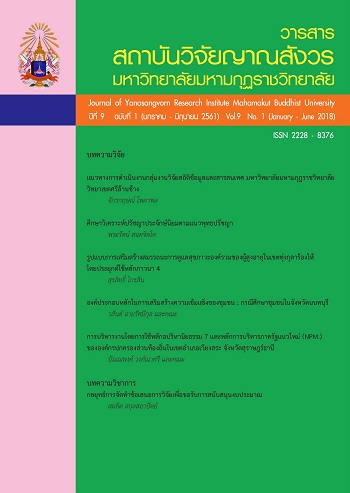A STUDY CONSUMERISM FACTOR OF UNDERGRADUATE STUDENTS IN RAMKHAMHAENG UNIVERSITY
Main Article Content
Abstract
This research aimed to investigate consumerism elements of bachelor’s degree students in Ramkhamhaeng University for the semester 1 in the academic year 2017. The research required the sample group more 20 times of question items because it was the elemental study, which specified the factor analysis condition of a sample group of 1,360 students. The data were collected from the actual sample group of 1,470 students. The instrument of this research was the questionnaire and item discrimination (r > 0.20), analyzed to calculate reliability by Croncach’s alpha coefficient in terms of consumerism behavior equal to 0.871 and consumerism attitude equal to 0.862. The data were analyzed by the inferential statistics of Exploratory Factor Analysis (EFA) through the statistical package of Principal Component Analysis (PC) and Orthogonal Rotation by Varimax Method to find out consumerism elements of bachelor’s degree students in Ramkhamhaeng University. The result showed that consumerism elements of bachelor’s degree students in Ramkhamhaeng University consisted of 2 aspects including Consumerism behavior consisted of 5 elements, i.e., Element 1 luxury good consumption behavior, Element 2 convenience consumption behavior, Element 3 brand name consumption behavior, Element 4 service consumption behavior, and Element 5 entertainment consumption behavior. Consumerism attitude consisted of 5 elements, i.e., Element 1 luxury good consumption attitude, Element 2 convenience and entertainment consumption attitude, Element 3 brand name consumption attitude, Element 4 good and service consumption behavior, and Element 5 fast food and trendy snack consumption behavior.
Article Details
References
จุฑารัตน์ ก้านจักร. (2548). การศึกษาความสัมพันธ์ระหว่างการรับเทคโนโลยีกับพฤติกรรมบริโภคนิยมของนักศึกษามหาวิทยาลัยเทคโนโลยีพระจอมเกล้าธนบุรี. วิทยานิพนธ์ครุศาสตร์อุตสาหกรรมมหาบัณฑิต, มหาวิทยาลัยเทคโนโลยีพระจอมกล้าธนบุรี.
นงลักษณ์ กองหลัง. (2552). การวิเคราะห์พฤติกรรมบริโภคนิยมของนิสิตปริญญาตรี มหาวิทยาลัยมหาสารคาม. วิทยานิพนธ์การศึกษาศาสตรมหาบัณฑิต, มหาวิทยาลัยมหาสารคาม.
มาริสา จันทร์ฉาย. (2551). พฤติกรมบริโภคนิยมของนักศึกษา มหาวิทยาลัยสงขลานครินทร์ วิทยาเขตหาดใหญ่. วิทยานิพนธ์พัฒนามนุษย์และสังคมมหาบัณฑิต, มหาวิทยาลัยสงขลานครินทร์ วิทยาเขตหาดใหญ่.
ศิรินรา บุดดานอก. (2552). การเปรียบเทียบเจตคติต่อการมีเพศสัมพันธ์ในวันเรียนและพฤติกรรมบริโภคนิยมของนิสิต นักศึกษา ในจังหวัดมหาสารคามที่มีเพศ ชั้นปี และความเชื่อมั่นในตนเองแตกต่างกัน. วิทยานิพนธ์การศึกษาศาสตร.
สุวิมล ติรกานันท์. (2549). การใช้สถิติในงานวิจัยทางสังคมศาสตร์: แนวทางสู่การปฏิบัติ กรุงเทพมหานคร: โรงพิมพ์แห่งจุฬาลงกรณ์มหาวิทยาลัย.
สุวิมล ติรกานันท์. (2553). การวิเคราะห์ตัวแปรพหุในงานวิจัยทางสังคมศาสตร์ กรุงเทพมหานคร: โรงพิมพ์แห่งจุฬาลงกรณ์มหาวิทยาลัย.
Blackwell, R., Miniard, P. W., & Engel, J. F. (2006). Consumer behavior. 10th Edition. Mason, OH: Thomson/South-Western.
Bourdieu, P (1979). Distinction: A Social Critique of the Judgement of Taste. London: Routledge.
Hair , Jr., J. F., Black, W. C., Babin, B. J. and Anderson, R. E. (2010). Multivariate Data Analysis. 7th ed. New Jursey : Pearson Education, Inc.
Solomon, Micheal R.(1996). Consumer Behavior. New Jersey : Prentice Hall International.
Theodeor Adorno, On popular music,in Cultural Theory and Popular Culture: A Reader, edited by. John Storey , Hemel Hempstead: Harvester Wheatsheaf,1994.


